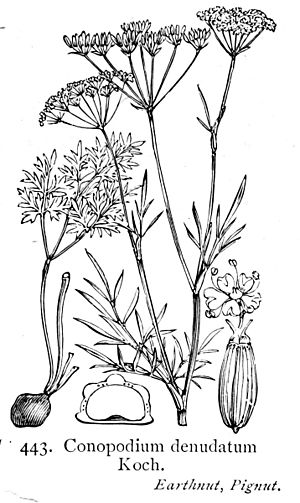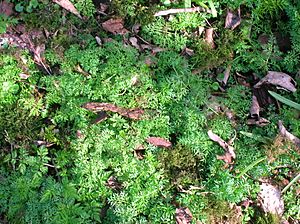Conopodium majus facts for kids
Quick facts for kids Conopodium majus |
|
|---|---|
 |
|
| Scientific classification | |
| Genus: |
Conopodium
|
| Species: |
majus
|
| Synonyms | |
|
Bunium flexuosum Stokes |
|
Conopodium majus is a wild plant that grows in many parts of Europe. It is a perennial plant, meaning it lives for more than two years. It belongs to the Apiaceae family, which also includes celery and carrots.
This plant has an underground part that looks a bit like a small chestnut. People sometimes eat this part as a root vegetable. It has many common names, like kippernut, arnut, earth chestnut, and pignut. The name "pignut" comes from the fact that pigs love to dig up and eat these tasty nuts!
Contents
What Does It Look Like?
This plant has a smooth, thin stem that can grow up to 40 centimeters (about 16 inches) tall. Its leaves are divided into many small parts. It has tiny, white flowers that grow in clusters shaped like umbrellas.
The "nut" part of the plant grows underground. It is round and brown, much like a small chestnut. It can be up to 25 millimeters (about 1 inch) wide. People say its taste is sweet and smells nice. Some compare its flavor to chestnuts, hazelnuts, sweet potatoes, or even Brazil nuts.
These underground nuts are good to eat and full of nutrients. Many people who look for wild foods enjoy finding them. However, they are not grown much as a farm crop. This is because the plant does not produce many nuts, and they are hard to harvest.
Where Does It Grow?
Conopodium majus is common in western Europe, the British Isles, and Norway. You can often find it growing in hedgerows, woods, and open fields. If you see this plant, it often means the grassland has been there for a very long time.
Growing Pignuts
This plant usually does not grow in soils that are very alkaline (the opposite of acidic). It prefers certain types of soil, like those found in its natural home.
If you grow pignuts carefully, they can produce bigger nuts. With special breeding, it might be possible to grow plants that produce many more nuts.
Pignuts in History and Culture
Pignuts have been known and used for a long time.
Shakespeare and Pignuts
The famous writer William Shakespeare mentioned pignuts in his play The Tempest. One of his characters says: "I prithee, let me bring thee where crabs grow; and I with my long nails will dig thee pignuts". This shows that digging for pignuts was a common activity back then.
Culpeper's Herbal
Nicholas Culpeper was a famous English botanist and herbalist. In his book Complete Herbal, he wrote about pignuts: "A description of them were needless, for every child knows them." He also wrote that the root and seeds were used to help the body get rid of water. He suggested that the dried root, made into a powder, was good for stopping bleeding.
See also
 In Spanish: Castañuela para niños
In Spanish: Castañuela para niños


